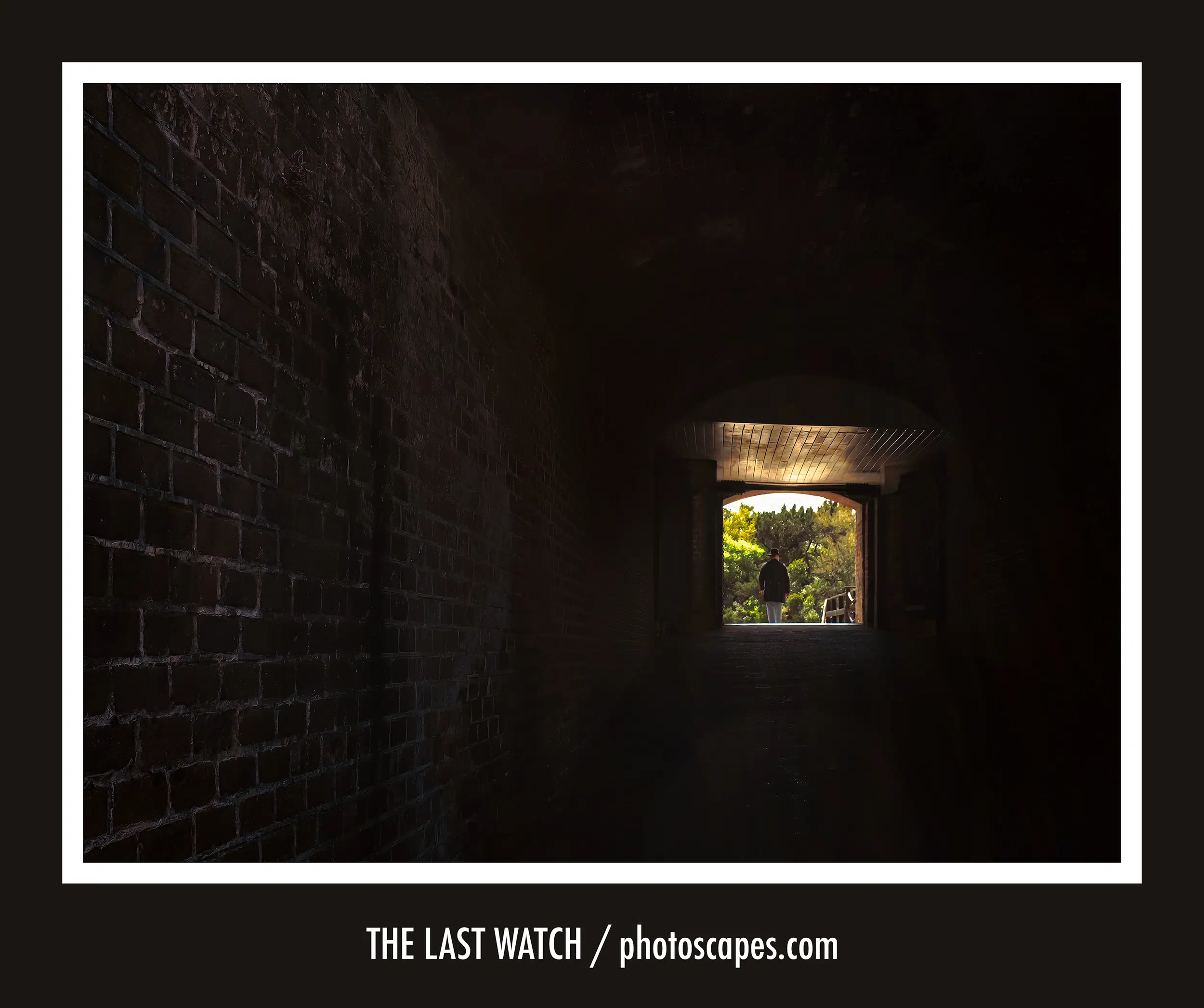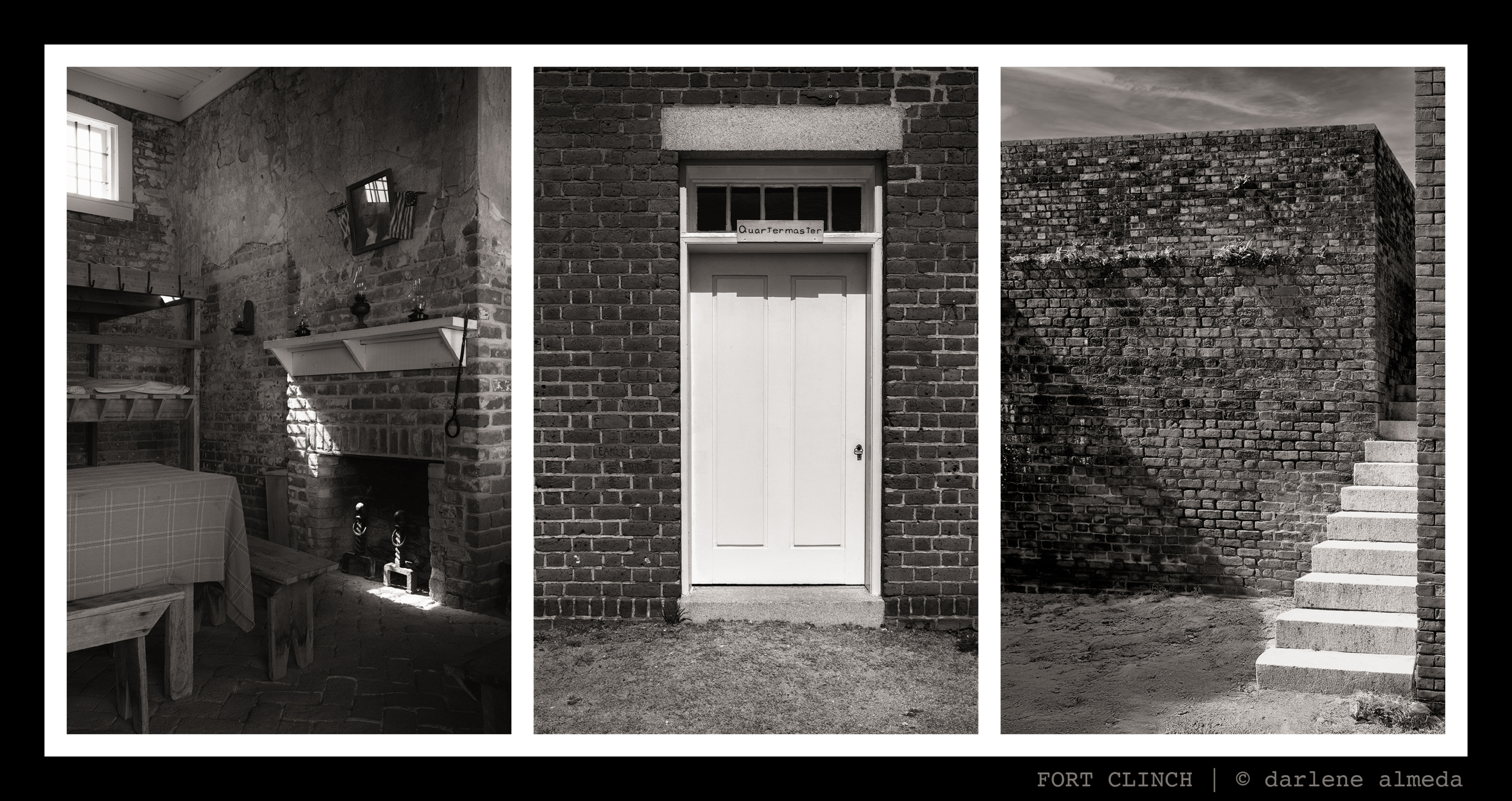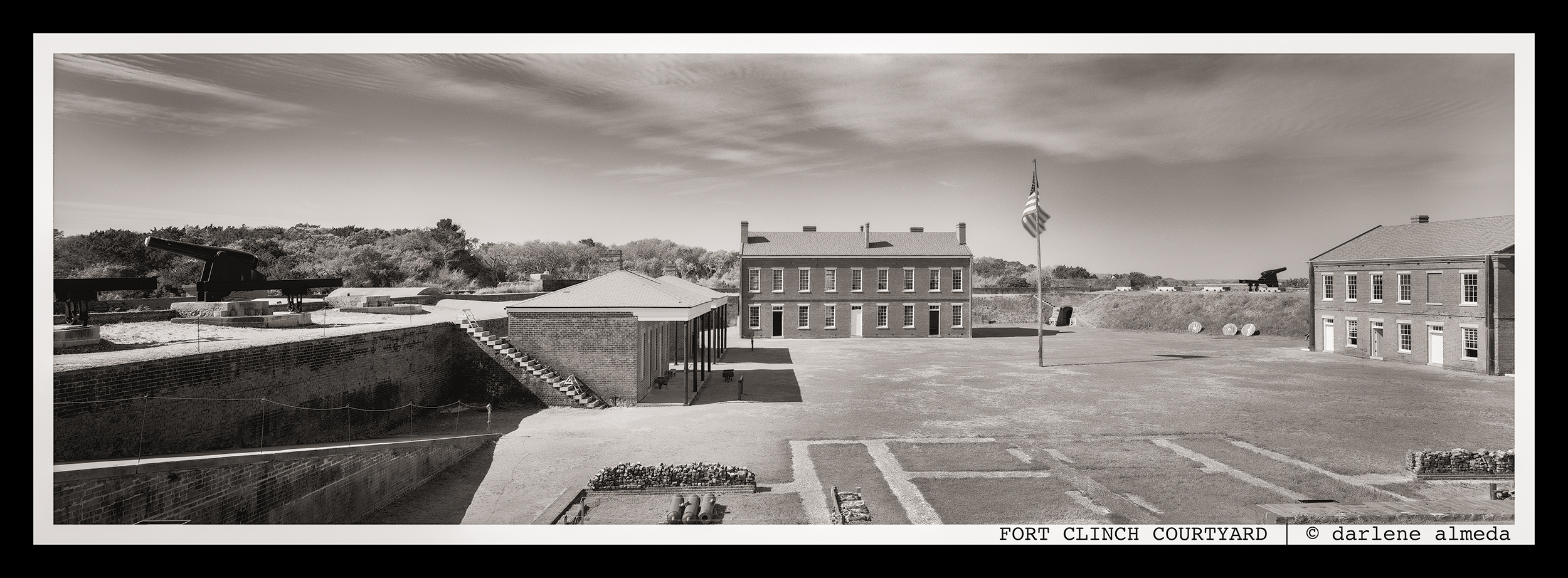
Camera: Fujifilm X100V Lens: Fujifilm XF 23 f/2.0 Digital: 26 MP [24x16] CMOS Software: Adobe Lightroom
Location: Amelia Island, FL Date: March 2025 Lighting: Daylight Genre: Narrative
Sometimes, a photograph invites more than a description of light or gear—it asks for a story. The Last Watch is one of those images.
What follows is a fictional tale—a moment imagined behind the lens, where time blurs and two worlds briefly meet.
PART ONE: THE PHOTOGRAPHER’S ENCOUNTER
I hadn’t planned to photograph anyone that day. Fort Clinch was still and empty, except for the breath of wind off the water and the soft crunch of gravel beneath my feet. I’d gone looking to make black-and-white 6×17 film images of the fort’s structures—for the contrast of cool shadow and the slant of morning light along worn stone.
I wandered into a long, arched tunnel—quiet and dark, like stepping inside the ribcage of history. The air shifted, cooler there, as if the walls were holding stories just beneath their surface.
And then I saw him.
A man at the far end of the tunnel, perfectly framed in the rectangle of light. He wore a Union uniform. Not modern, not costume-like—something about the way he stood made it feel real, lived-in. His posture was still, alert. Watching the trees beyond the fort walls. Guarding something no longer there.
I raised my pocket camera instinctively. One frame.
When I stepped forward into the light, he was gone.
I thought perhaps he was a reenactor or someone heading back to change out of uniform. But no one else saw him. And when I asked one of the rangers, she only smiled:
“People see him sometimes. Always in the tunnel. Always walking away.”
I gave him a name: Sergeant Samuel Peters.
A fictional name, perhaps—but not a fictional presence. In my mind, he was the last to leave—or maybe the one who never did. Duty stitched into brick and shadow. Time blurred into memory.
He’s just a silhouette now in the photograph.
A shape caught between light and dark.
But I know what I saw.
And I believe he saw me, too.
PART TWO: THE WATCHMAN’S TALE
WHEN WALLS FACED THE SEA / FUJIFILM X100V
They say Fort Clinch is empty now—just brick and silence.
But each morning, as dawn filters through the pines and spills across the ramparts, he walks.
Sergeant Samuel Peters received his orders in the spring of 1864: report to the northernmost tip of Florida, to a remote outpost overlooking the sea. Fort Clinch, weathered and stubborn, stood like a lone sentinel at the edge of the continent. The war was winding down. Rumors of peace drifted in with the tide. But Peters held fast to duty.
He manned the watch, inspected the armory, and wrote letters to his wife in Georgia, folding them neatly and carefully in a satchel that no courier ever claimed.
One morning, the others were gone. No notice. No orders. Just silence. The cookfire lay cold. The barracks, still made. Peters searched the tunnels, the gun ports, the seawall—no trace. Only the echo of his boots on worn stone.
Days bled into months. Seasons came and passed like ghosts. Time loosened its grip. Peters became part of the fort’s breath, woven into the mortar, etched into shadow.
Now, visitors wander its halls—families, photographers, sun-washed tourists with maps in hand. Some pause in the shade of the archway, squinting. A man in blue, they say, just ahead—always just ahead—disappearing into shadow or framed against the light at the end of a corridor. They don’t hear his footsteps, but they feel him. Still. Steady. Watching.
And every evening, as the last light slants low through brick and memory, Sergeant Samuel Peters walks again—through the tunnel, past the moss-darkened walls, toward the gate and the golden blur of trees beyond.
Still waiting.
Still holding his post.
FORT CLINCH TRIPTYCH / FUJIFILM X100V
EPILOGUE
Standing in the stillness of Fort Clinch, camera in hand, I felt the weight of history pressing gently from every wall. Places like this are layered—not just with national memory but with personal echoes if you’re quiet enough to hear them.
As I stood where others once stood, where watchful eyes once scanned the horizon, I thought about how many untold stories live in these bricks. And I thought about my own.
My great-great-grandfather and his brother were Native Americans who served in the Union Army during the Civil War. After the war, he settled near Brotherton, New Jersey. His life was rooted in service, resilience, and the land.
And sometimes I wonder—what if it had been him? Or his brother? What if one of them once stood watch from a post like this, steady and silent, carrying both the weight of the nation and the memory of their people?
The man I photographed that morning may be a figure of fiction. But in the blur between light and shadow, imagination and memory, something real revealed itself.
A thread pulled tight—connecting the past not just to the present but to me.
FORT CLINCH COURTYARD / FOTOMAN 6×17
Later that day, I carried my Fotoman 6×17 film camera up to the top of the fort walls, where the old cannons still rest. I paused there, looking out across the grounds and beyond—toward the Atlantic Ocean. I made one more image, this time on black-and-white film, with wind in my hair and salt in the air. It will become part of this story, too. It wasn’t an easy image to make—there were plenty of obstacles up top—but I managed to find a clean angle and came away with a frame I really like.
The Last Watch may not be a visually spectacular image by traditional standards—at best, I’d call it an average frame with a little punch. But it sparked something deeper. It stirred my imagination and led me to write a story that reflects not only my curiosity about those who once served at Fort Clinch, but also my connection to my own Civil War veteran ancestors.
If you ever find yourself moved by a photograph—whether your own or someone else’s—I encourage you to write alongside it. Tell the truth. Imagine the fiction. Let the image speak, and then speak back. Often, the most powerful stories are the ones we didn’t expect to tell.



